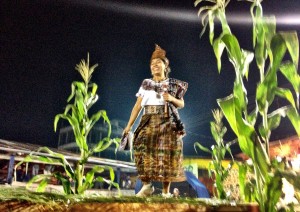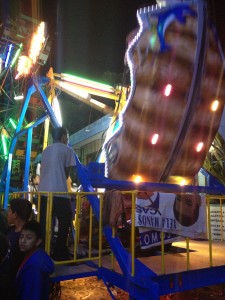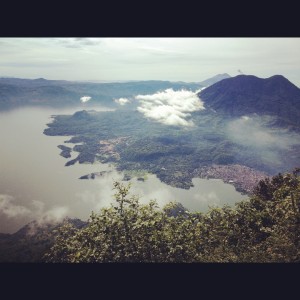Vagablogging Field Reports: aprendiendo Español en San Pedro la Laguna, Guatemala
Cost: $25 a day
The strangest thing I’ve seen lately
Few people outside of the small town of San Pedro la Laguna on the shore of Lake Atitlan in the Guatemalan highlands have heard of the San Pedro Celtics basketball team. With a population of approximately thirteen thousand people, mostly of Mayan descent, one could be forgiven for thinking that there wasn’t a basketball team at all in this soccer (fútbol) mad part of the world. But exist they do and although the players lack that most important asset of a good basketballer- height- they play with a speed, determination and passion that is commendable. Of course, these attributes don’t tend to matter when they come up against players who are two feet taller than they are; which is exactly what happened recently when the Celtics were pitted against a selection of some of the finest professional Guatemalan players- team Seleccion. The Seleccion came to town during the annual week of festivities, celebrating the Apostle Peter, who the town is named after.
Team Seleccions players, some of whom apparently play for the Guatemalan national team, arrived fashionably late with a group of attractive girls in tow. Most of these giants appeared to have European blood in them and they towered over the short, squat players the Celtics Mayan blood had produced. Once the Seleccion posse had settled into some seats the players started a fairly serious looking warm up routine as the locals practiced their shooting down the other end of the court.
During the warm up I was surprised at how few people had shown up to watch the elite of Guatemalan basketball play, especially given that it was mid fiesta and the court is right next to the town centre. Once the game started, however, it was a different story. The locals seemed to emerge from thin air and surround the court despite the game starting thirty minutes late. The crowd wasn’t a particularly boisterous one but they clapped whenever the Celtics netted. They kept a deathly silence when Seleccion scored, which was a lot more frequently. No one seemed to notice, or care, that a dog had decided to take a snooze on the court mid game.
It struck me as strange that a group of professionals would travel to San Pedro to play a rag tag team of locals, some of whom are well over forty years old. Having said this, the Seleccion players chief asset was their height and their ball skills were about as good as the San Pedro Celtics, which is to say, not the best. In fact for a short time it looked like the Celtics may cause an upset as they scored the first six points of the game.
Chief play maker for the locals was Luis, one of the teachers at the Cooperativa Spanish School that I have been studying at. He scored the first four points of the game and always looked a threat, however as the game wore on the height of the Seleccion players started to tell, and one particularly enormous player started swatting the Celtics shots out of the air like a cat playing with a ball of string. Eventually Seleccion sorted themselves out and came away with a 73 to 41 point win.
A typical day
After waking I head into the kitchen of the simple, small house on the hill that I am staying in. Maria, my host mother, serves me breakfast and chats to me in Spanish. She looks like a typical Mayan lady- the top of her head is barely five foot off the ground and she has dark brown skin, jet black hair and short stubby limbs and fingers. She is always dressed in a traditional colourful dress that on any given day may be pinks, reds, greens, blues, white and black. She has a warm personality and often laughs at her own jokes. When she erupts in laughter I seldom understand what she has actually said, however her chortle is infectious and since I don’t want to look like an idiot I make sure to laugh too. Of course this has the effect of making me look like even more of an idiot when she figures out I have no idea what’s so comical. Every day the food is different but always delicious- fresh fruits, fried plantaines, beans, eggs, porridge, tamales or banana pancakes.
After breakfast I go back to my room and try to psyche myself up for another cold shower. Since getting to Guatemala three weeks ago my skin has not touched warm water, despite the shower in my room having an electrical contraption that’s supposed to provide some heat. Sometimes I fail to achieve the satisfactory He-Man status needed brave the cold water so I head to my Spanish classes a touch grubby.
La Cooperativa, as the name suggests is a cooperative Spanish school run by local teachers who all have equal ownership and input into how the school is run. My teacher, Griselda is a diminutive Mayan woman who has a keen intellect and great sense of humour. She has been teaching Spanish for thirteen years and has heard it all. She listens to me patiently as I fumble my way through four hours of Spanish and only laughs occasionally when I call my grandfather a tree or tell her that someone defecated rather than died.
After my lessons I head back up the hill to Maria’s kitchen where she has prepared another wholesome meal. I gobble it up quickly so I can head into the small room next door where the television resides. The European Cup is on and I sit down on a plastic chair reserved for me right in front of the television. I’m flanked by Juan, Maria’s sixteen year old son and her husband Manuel. Juan and I mainly communicate by naming fútbol stars and asking each other whether we like them or not. I manage to say in faltering Spanish that I dislike Cristiano Ronaldo because he is arrogant and changes his hair-do at half time. Juan doesn´t seem to care but suggests that perhaps his name should Cristiana instead. Lufe and Ada Mare the two daughters poke their heads in when someone yells ‘Golaaaaazo!’, even though they both prefer basketball. Often the family will speak in their local Tzutujil Mayan tongue. With its short sharp words and tongue-clicking sounds it´s very easy to distinguish it from Spanish.
At night we all head to the streets to see what festivities the annual celebration has brought to town. There are the usual things one might expect- games, junk food and amusement rides- but everything is a little different to what I have experienced in the past. The games are unfamiliar, the food has a Latin spin and the amusement rides look awfully perilous. I play the loteria (similar to bingo) and we manage to win a round. Maria takes home a nice set of plates as a prize.
I join Juan, Lufe and Ada Mare on a couple of rides that appear to lack the safety standards I am used to back home. First we hop on a Ferris wheel that is powered by a tractor at the base of it. This would be fine except that it spins ten times faster than a typical Ferris wheel and the seat swings a little too much for my liking. We all survive and then walk over to a ride called ‘Viking King’, which is a fake ship that swings back and forth wildly and is hand operated by a guy cranking on a bit of metal sticking out the side of the ride. ‘This is a little unconventional’ I think as the man stops the ride for the current passengers by pulling on a metal lever. The ride makes a clunking sound and then groans to a standstill.
Once aboard the ship starts swinging wildly and it quickly becomes apparent that my suspicions are correct- the ride is really quite sketchy. When our end of the ship swings up we are lifted off our seats and stopped from flying fifty metres through the air by a flimsy metal bar locked into place over our laps by an equally flimsy latch. The guy operating the crank screams at me to put my hands inside the bar (adentro!) as one of them inadvertently brushes the latch. “Sorry pal I’m fighting for my God damn life here”, I don’t scream (my Spanish isn’t that far advanced yet). We survive but two days later I find my safety concerns were valid when Maria, after some unusual gesturing manages to explain that two people have been hurled out of the Viking King. Thankfully they were only maimed a little and can live to tell the tale of the day the Viking King challenged their mortality.
After our brush with death I politely decline hopping aboard any more rides and we make our way back to the house, stopping every now and then to play a game or sample some fried junk food. As we walk up the main drag two things become apparent: the locals are very tactile with one another and they walk agonizingly slowly. Maria hangs of my arm the whole way up the hill and I have to make a concerted effort to walk very unhurriedly. Maybe it is their short legs but I get the feeling the people of San Pedro just like to take things at a much slower pace than I am accustomed to in order to savour the moment.
Griselda has given me homework, as all good teachers do, and when I get back to my room I do it with tired eyes before turning in. Although for the most part I sleep well tonight I’m awoken several times by dogs barking, cats yowling, bombas exploding and on one occasion the trembling of the earth itself as the town is shaken by a minor earthquake. During this time of the year there doesn’t appear to be a dull hour night or day in San Pedro la Laguna.
An interesting conversation with a local:
Since I’m mainly interacting with Spanish speakers conversations can be somewhat one way with me nodding my head and saying ‘sí’ as a local riffs at me. Over the course of the two weeks however my ability to understand these encounters has improved significantly. I have my most in depth conversations with Griselda, who understands when I throw some Spanglish into the mix. Since Griselda is a tiny, Mayan woman who likes to sew in her spare time it is fair to say that we are very different people. But despite this, when it comes to her opinion on the fundamental aspects of life that are important- the health, safety and availability of good quality education for family and friends- we differ very little. One glaringly obvious difference, however, is that these fundamentals are a hell of a lot easier for me to obtain than for any individual in Guatemala.
What I like/dislike about where I am
Guatemalan people are renowned for their patience and the clarity of their spoken Spanish. Since a main goal of mine whilst making my way through Latin America is to learn Spanish both of these attributes are a blessing. When I approach a local they will stand there smiling and waiting for me to spit out the necessary words. Even people who are accomplished English speakers give you a chance to converse in Spanish as they seem to understand that at least attempting to converse in the local tongue is an important part of the learning process.
This brings me to something I loathe and recently encountered at a hostel I stayed at. I was relaxing in a hammock, reading a book (‘Into thin Air’ by John Krakauer – awesome) when I heard a woman with an unmistakable Australian twang complain to a friend that not enough people spoke English in Guatemala and that more of the signs should at least be in English. Her voice sounded like a crow in the throws of death as she screeched at her friend who was a mere foot away from her face. Her foul words sliced though the dull hum of the people chatting in the common area and injected themselves into my ear. I immediately went for my headphones on the table next to me like an air passenger grasping for an oxygen mask as their plane goes down.
I wonder why people with qualms like this travel at all. Perhaps they want a homogenized experience in a foreign land at a quarter of the price they could get back home. Hearing someone bitch about things that should be embraced is always a shame and it somehow seems even worse when they are the same nationality as you are.
This seems as good a time as any to bring up a minor issue I have had with the locals rather than a fellow foreigner whilst in Guatemala. Although I hate to admit it, I was born with fragile nerves inherited from my dear father who screams as if he has been mortally wounded whenever there is a sharp, loud sound. It was common in my household to hear a smash in the kitchen followed by a horrific scream. My brothers and I would rush into the kitchen to find my father unblemished and a broken glass on the floor. Now that I have firmly established that it’s all my father’s fault, I can reveal that every time a firecracker (bomba) goes off here I jump out of my skin.
Guatemaltecos love bombas, especially during annual celebrations and it appears that in San Pedro they love nothing more than setting one off at fifteen minute intervals from six in the morning to midnight. Bombas are different to fireworks in that there is no visual spectacle. Their sole purpose appears to be to make a really loud, obnoxious noise resembling heavy artillery. To Griselda’s delight I jump out of my seat with astounding regularity. I managed to restrain myself from shrieking uncontrollably, something of which if I´m to be honest, I´m a little proud of.
A challenge
Trying to speak Spanish as much as possible has been the biggest challenge. Guatemala has no shortage of travellers and many of the locals speak English well enough so that you wouldn’t need to speak a word of Spanish at all if you didn’t desire. Of course this would severely impact my enjoyment so I try and speak Spanish whenever possible, even if I know their English is in all likelihood better than my Spanish. This can make even the simplest of conversations incredibly rewarding. I have performed a couple of epic fist pumps after successfully getting directions or ordering food without a hitch.
A lesson
It’s important to take the time to learn and try speaking the local language even if you make a bit of a fool of yourself from time to time.
Also the following:
arbol= tree, abeulo= grandfather
muerte= death, mierda= shit
Where next?
More of Guatemala and then onwards to Honduras
You can follow me on Twitter @ash_jordan or Instagram “ashgjordan (I’m in desperate need of more online friends…… I don’t look very cool right now)






Category: Central America, Languages and Culture, Vagabonding Field Reports